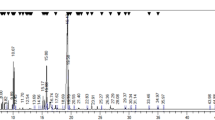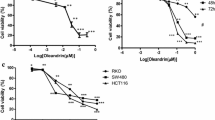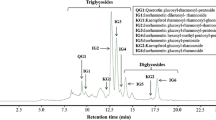Abstract
Quercetin, which is the most abundant bioflavonoid compound, is mainly present in the glycoside form of quercitrin. Although different studies indicated that quercitrin is a potent antioxidant, the action of this compound is not well understood. In this study, we investigated whether quercitrin has apoptotic and antiproliferative effects in DLD-1 colon cancer cell lines. Time and dose dependent antiproliferative and apoptotic effects of quercitrin were subsequently determined by WST-1 cell proliferation assay, lactate dehydrogenase (LDH) cytotoxicity assay, detection of nucleosome enrichment factor, changes in caspase-3 activity, loss of mitochondrial membrane potential (MMP) and also the localization of phosphatidylserine (PS) in the plasma membrane. There were significant increases in caspase-3 activity, loss of MMP, and increases in the apoptotic cell population in response to quercitrin in DLD-1 colon cancer cells in a time- and dose-dependent manner. These results revealed that quercitrin has antiproliferative and apoptotic effects on colon cancer cells. Quercitrin activity supported with in vivo analyses could be a biomarker candicate for early colorectal carcinoma.







Similar content being viewed by others
References
Jemal A, Bray F, Center MM et al (2011) Global cancer statistics. CA Cancer J Clin 61:69–90
Akao Y, Nakagawa Y, Naoe T (2006) MicroRNAs 143 and 145 are possible common onco-microRNAs in human cancers. Oncol Rep 16:845–850
Valeri N, Gasparini P, Fabbri M et al (2010) Modulation of mismatch repair and genomic stability by miR-155. Proc Natl Acad Sci U S A 107:6982–6987
Wattenberg LW (1985) Chemoprevention of cancer. Cancer Res 45:1–8
Boone CW, Kelloff GJ, Malone WE (1990) Identification of candidate cancer chemopreventive agents and theirevaluation in animal models and human clinical trials: a review. Cancer Res 50:2–9
Reddy BS (2000) The Fourth DeWitt S. Goodman lecture. Novel approaches to the prevention of colon cancer bynutritional manipulation and chemoprevention. CancerEpidemiol. Biomark Prev 9:239–247
Cody V (1988) Crystal and molecular structures of flavonoids. Prog Clin Biol Res 280:29–44
Pietta PG (2000) Flavonoids as antioxidants. J Nat Prod 63:1035–1042
Tripoli E, Guardia ML, Giammanco S et al (2007) Citrus flavonoids: molecular structure, biological activity and nutritional properties: a review. Food Chem 104:466–479
Pilsakova L, Riecansky I, Jagla F (2010) The physiological actions of isoflavone phytoestrogens. Physiol Res 59:651–664
Domitrovic R (2011) The molecular basis for the pharmacological activity of anthocyans. Curr Med Chem 18:4454–4469
Tanaka T, Takahashi R (2013) Flavonoids and asthma. Nutrition 5(6):2128–43
Ding M, Zhao J, Bowman L et al (2010) Inhibition of AP-1 and MAPK signaling and activation of Nrf2/ARE pathway by quercitrin. Int J Oncol 36(1):59–67
Sa’nchez de Medina F, Vera B, Ga’lvez J et al (2002) Effect of quercitrin on the early stages of hapten induced colonic inflammation in the rat. Life Sci 70:3097–3108
Gee JM, DuPont MS, Rhodes MJ et al (1998) Quercetin glucosides interact with the intestinal glucose transport pathway. Free Radic Biol Med 25:19–25
Wagner C, Fachinetto R, Dalla Corte CL et al (2006) Quercitrin, a glycoside form of quercetin, prevents lipid peroxidation in vitro. Brain Res 1107:192–198
Cruz EA, Da-Silva SA, Muzitano MF et al (2008) Immunomodulatory pretreatment with Kalanchoe pinnata extract and its quercitrin flavonoid effectively protects mice against fatal anaphylactic shock. Int Immunopharmacol 8(12):1616–21
Yang HM. Ham YM. Yoon WJ. Roh SW. Jeon YJ. et al. (2012) Quercitrin protects against ultraviolet B-induced cell death in vitro and in an in vivo zebrafish model. J. Photochem. Photobiol. B Sep 3;114:126–31
Camuesco D, Comalada M, Rodrguez-Cabezas ME et al (2004) The intestinal anti-inflammatory effect of quercitrin is associated with an inhibition in iNOS expression. Br J Pharmacol 143:908–918
Comalada M, Camuesco D, Sierra S et al (2005) In vivo quercitrin anti-inflammatory effect involves release of quercetin, which inhibits inflammation through down-regulation of the NF-kappaB pathway. Eur J Immunol 35(2):584–92
Sánchez de Medina F, Vera B, Gálvez J, Zarzuelo A (2002) Effect of quercitrin on theearly stages of hapten induced colonic inflammation in the rat. Life Sci 70(26):3097–108
Browning AM, Walle UK, Walle T (2005) Flavonoid glycosides inhibit oral cancer cell proliferation–role of cellular uptake and hydrolysis to the aglycones. J Pharm Pharmacol 57(8):1037–42
Xu R, Zhang Y, Ye X, Xue S, Shi J et al (2013) Inhibition effects and induction of apoptosis of flavonoids on the prostate cancer cell line PC-3 in vitro. Food Chem 138(1):48–53
Ly JD, Grubb DR, Lawen A (2003) The mitochondrial membrane potential (deltapsi(m))in apoptosis; an update. Apoptosis 8(2):115–28
Acknowledgments
This work was supported by the Istanbul University Scientific Research Projects; 31162. We would like to thank to Mr. David Chapman for English editing.
Conflict of interest
The authors declare that they have no financial disclosures or conflicts of interest.
Author information
Authors and Affiliations
Corresponding author
Rights and permissions
About this article
Cite this article
Cincin, Z.B., Unlu, M., Kiran, B. et al. Apoptotic Effects of Quercitrin on DLD-1 Colon Cancer Cell Line. Pathol. Oncol. Res. 21, 333–338 (2015). https://doi.org/10.1007/s12253-014-9825-3
Received:
Accepted:
Published:
Issue Date:
DOI: https://doi.org/10.1007/s12253-014-9825-3




